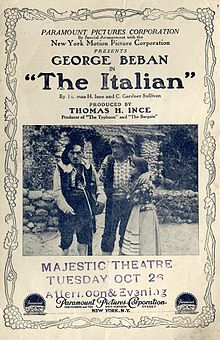There’s no debate that Italian culture has shaped what we today refer to as “America” in myriad ways. Yet in film Italian-Americans are often cast as mafiosos and gangsters, hoodlums and thugs. Below is a list of eight films that expand how we think about Italian-Americans in film and don’t fall into cliche. There are some gangsters among this bunch, yes, but also parents, lawyers, business owners, and dreamers, too.

The Italian (1915)—In this silent feature, one of the earliest cinematic renderings of the Italian immigrant experience, Beppo, a handsome gondolier, makes the voyage to New York to earn some money to purchase passage back home for his sweetheart, Annette. For some time, luck is on his side, and the American Dream seems within reach. Annette joins him, they marry, and they have a child not long after—but a blistering, dangerous heat wave reveals just how tenuous their life actually is. Though San Francisco immigrant neighborhoods are used as stand-ins for New York City, The Italian still captures the bustle and squalor of some of the 20th century’s most dynamic communities.

Scarface (1932)—Many viewers are likely familiar with the 1983 Brian De Palma–directed, Al Pacino–starring Scarface, in which the titular gangster leaves Cuba to stake out a claim in Miami. The original, directed by Howard Hawks, is a cautionary tale set in the early ’30s in Chicago. It was made as a reaction to the rampant gang violence of the time. Paul Muni plays Tony Camonte, a lower-level thug with a scarred face who is just clever and craven enough to kill and scheme his way to the top, but not smart enough to know that no amount of killing or thuggery will earn him what he really desires: class. This grim classic, one of the greatest of all gangster films, advertises itself as based on true events.

Italianamerican (1974)—In 2013 Martin Scorsese declared Italianamerican his best film. The intimate, lovingly ramshackle documentary about his mother and father was made in the apartment in which he grew up. The director’s claim is debatable, but fans of his work will certainly recognize it as Scorsese through and through, from the formal flourishes to the nervy energy and the keen appreciation for average individuals caught up in the sweep of massive historical change. Here, two parents try to straddle the Old World and the new. Scorsese’s mom, Catherine, steals the show and shares with her curious son the secrets to making a perfect meatball.

Prizzi’s Honor (1985)—John Huston’s filmmaking was elastic enough to span 1940s classics like The Maltese Falcon and Key Largo and independently minded 1970s productions like Wise Blood and Fat City, then wind up at 1987’s elegiac, literary The Dead, based on James Joyce’s story. Prizzi’s Honor, Huston’s penultimate film, deploys a near unclassifiable tone to tell the tale of an Italian hit man, played by Jack Nicholson, who falls madly in love with a Polish hit woman, played by Kathleen Turner, working at cross-purposes with the family he serves. Is it romance shot through with murder? A grim mafia drama gummed up with belly laughs? There’s not much else like it.

Do the Right Thing (1989)—It’s another sweltering New York summer, and tempers are on the rise. In Brooklyn’s Bedford-Stuyvesant (Bed-Stuy) neighborhood, a long-running Italian-owned pizzeria in a now largely black neighborhood becomes a flashpoint for the neighborhood’s simmering racial tensions. This, the movie that put Spike Lee on the map, is one of the great American films of the period, and remains one of the quintessential movies about the moment when neighborhoods change hands.

The Godfather III (1990)—The first installments in Francis Ford Coppola’s storied trilogy have long since settled into their deserved status as landmarks. The daffy, often clunky closing chapter (Coppola himself refers to it as an “epilogue”) deserves reconsideration. The first two films tracked the Corleone family’s arrival in America and ascent to power; the last attempts to capture a more subtle set of changes. Paterfamilias Michael attempts to take the family across the final frontier of assimilation: legitimacy.

My Cousin Vinny (1992)—Some of the biggest of on-screen New Yawk accents are featured in this courtroom comedy set in Alabama. Freshly minted lawyer Vinny (Joe Pesci) and his girlfriend, Mona Lisa (Marisa Tomei), cut odd figures in backwoods Alabama, but the broadness of the stereotyping (on both sides) is counterbalanced by the film’s good humor and warmth. Over the years, the courtroom accuracy (director Jonathan Lynn earned a law degree at Cambridge) has made it an unlikely cult favorite among the legal set.

Big Night (1996)—The directorial debut of actors Campbell Scott and Stanley Tucci stars Tucci and Tony Shalhoub as brothers operating Paradise, the highest-quality, least-popular Italian restaurant on the 1950s Jersey Shore. Chef Primo (Shalhoub) refuses to compromise his Old World cuisine for American palates, making life difficult for his restaurant-manager brother, Secondo (Tucci). When a celebrated jazz singer promises to visit the restaurant, the brothers think their fortunes are looking up and prepare one of the most mouthwatering Italian feasts in movie history.